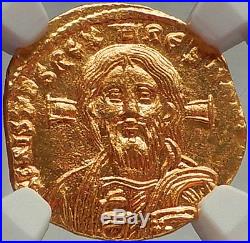
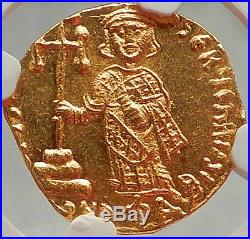
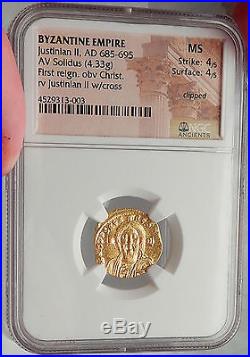
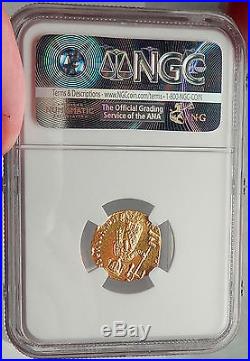
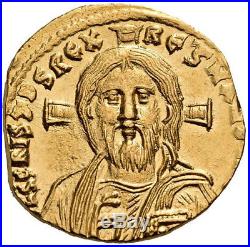
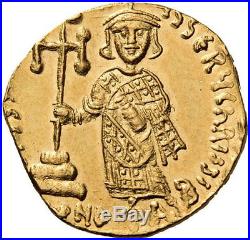

Justinian II – Byzantine Emperor, first reign, 685-695 A. Gold Solidus 17mm (4.35 grams) 7h, Constantinople, struck 692-695 A. Reference: DOC 8 (but this officina not recorded). SB 1249 Certification: NGC Ancients MS Strike: 4/5 Surface: 4/5 4529313-003 IhS CRISTDS REX REGNAN[TIuM] Draped bust of Christ facing, with long hair and full beard, raising right hand in benediction and holding book of Gospels in his left; behind head, cross. [D IuSTINIANu]S SERu ChRISTI’ / CONOPA Justinian II, crowned, bearded and wearing loros, standing facing, holding cross potent on base and two steps in his right hand and akakia in his left. The first ancient coin depicting Jesus Christ. Provided with certificate of authenticity. CERTIFIED AUTHENTIC by Sergey Nechayev, PhD – Numismatic Expert. Jesus (Greek: Iesous ; 7-2 BC to 30-33 AD), also referred to as Jesus of Nazareth , is the central figure of Christianity, whom the teachings of most Christian denominations hold to be the Son of God. Christianity regards Jesus as the awaited Messiah of the Old Testament and refers to him as Jesus Christ , a name that is also used in non-Christian contexts. Virtually all modern scholars of antiquity agree that Jesus existed historically, although the quest for the historical Jesuss has produced little agreement on the historical reliability of the Gospels and on how closely the biblical Jesus reflects the historical Jesus. Most scholars agree that Jesus was a Jewish rabbi from Galilee who preached his message orally, was baptized by John the Baptist, and was crucified in Jerusalem on the orders of the Roman prefect, Pontius Pilate. Scholars have constructed various portraits of the historical Jesus, which often depict him as having one or more of the following roles: the leader of an apocalyptic movement, Messiah, a charismatic healer, a sage and philosopher, or an egalitarian social reformer. Scholars have correlated the New Testament accounts with non-Christian historical records to arrive at an estimated chronology of Jesus’ life. The most widely used calendar era in the world (abbreviated as “AD”, alternatively referred to as “CE”), counts from a medieval estimate of the birth year of Jesus. Christians believe that Jesus has a “unique significance” in the world. Christian doctrines include the beliefs that Jesus was conceived by the Holy Spirit, was born of a virgin, performed miracles, founded the Church, died by crucifixion as a sacrifice to achieve atonement, rose from the dead, and ascended into heaven, whence he will return. The great majority of Christians worship Jesus as the incarnation of God the Son, the second of three persons of a Divine Trinity. A few Christian groups reject Trinitarianism, wholly or partly, as non-scriptural. In Islam, Jesus (commonly transliterated as Isa) is considered one of God’s important prophets and the Messiah. To Muslims, Jesus is a bringer of scripture and was born of a virgin, but neither the Son of God nor the victim of crucifixion. According to the Quran, Jesus was not crucified but was physically raised into the heavens by God. Judaism rejects the Christian and Islamic belief that Jesus was the awaited Messiah, arguing that he did not fulfill the Messianic prophecies in the Tanakh. Justinian II (Greek: , Ioustinianos II, Latin: Justinianus II) (669 – 11 December 711), surnamed the Rhinotmetos or Rhinotmetus (, “the slit-nosed”), was the last Byzantine Emperor of the Heraclian Dynasty, reigning from 685 to 695 and again from 705 to 711. Justinian II was an ambitious and passionate ruler who was keen to restore the Empire to its former glories, but he responded poorly to any opposition to his will and lacked the finesse of his father, Constantine IV. His second reign was even more despotic than the first, and it too saw his eventual overthrow in 711, abandoned by his army who turned on him before killing him. Justinian II was the eldest son of Emperor Constantine IV and Anastasia. His father raised him to the throne as joint emperor in 681 on the fall of his uncles Heraclius and Tiberius. In 685, at the age of sixteen, Justinian II succeeded his father as sole emperor. Due to Constantine IV’s victories, the situation in the Eastern provinces of the Empire was stable when Justinian ascended the throne. After a preliminary strike against the Arabs in Armenia, Justinian managed to augment the sum paid by theUmayyad Caliphs as an annual tribute, and to regain control of part of Cyprus. The incomes of the provinces of Armenia and Iberia were divided among the two empires. In 687, as part of his agreements with the Caliphate, Justinian removed from their native Lebanon 12,000 Christian Maronites, who continually resisted the Arabs. Additional resettlement efforts, aimed at the Mardaites and inhabitants of Cyprus allowed Justinian to reinforce naval forces depleted by earlier conflicts. Justinian took advantage of the peace in the East to regain possession of the Balkans, which were before then almost totally under the heel of Slavic tribes. In 687 Justinian transferred cavalry troops from Anatolia to Thrace. With a great military campaign in 688-689, Justinian defeated the Bulgars of Macedonia and was finally able to enter Thessalonica, the second most important Byzantine city in Europe. The subdued Slavs were resettled in Anatolia, where they were to provide a military force of 30,000 men. Emboldened by the increase of his forces in Anatolia, Justinian now renewed the war against the Arabs. With the help of his new troops, Justinian won a battle against the enemy in Armenia in 693, but they were soon bribed to revolt by the Arabs. The result was that Justinian was comprehensively defeated at the Battle of Sebastopolis, caused by the defection of most of his Slavic troops, while he himself was forced to flee to the Propontis. There, according to Theophanes, he took out his frustration by slaughtering as many of the Slavs in and around Opsikion as he could lay his hands on. In the meantime, aPatrician by the name of Symbatius proceeded to rebel in Armenia, and opened up the province to the Arabs, who proceeded to conquer it in 694-695. Meanwhile the Emperor’s bloody persecution of the Manichaeans and suppression of popular traditions of non-Orthodox origin caused dissension within the Church. In 692 Justinian convened the so-called Quinisext Council at Constantinople to put his religious policies into effect. The Council expanded and clarified the rulings of the Fifth and Sixth ecumenical councils, but by highlighting differences between the Eastern and Western observances (such as the marriage of priests and the Roman practice of fasting on Saturdays) the council compromised Byzantine relations with the Roman Church. The emperor ordered Pope Sergius I arrested, but the militias of Rome and Ravenna rebelled and took the Pope’s side. Justinian contributed to the development of the thematic organization of the Empire, creating a new theme of Hellas in southern Greece and numbering the heads of the five major themes- Thrace in Europe, Opsikion, the Anatolikon, andArmeniakon themes in Asia Minor, and the maritime corps of the Karabisianoi – among the senior administrators of the Empire. He also sought to protect the rights of peasant freeholders, who served as the main recruitment pool for the armed forces of the Empire, against attempts by the aristocracy to acquire their land- putting him in direct conflict with some of the largest landholders in the Empire. Through his agents Stephen and Theodotos, the emperor raised the funds to gratify his sumptuous tastes and his mania for erecting costly buildings. This, ongoing religious discontent, conflicts with the aristocracy, and displeasure over his resettlement policy eventually drove his subjects into rebellion. In 695 the population rose under Leontios, the strategos of Hellas, and proclaimed him Emperor. Justinian was deposed and his nose was cut off (later replaced by a solid gold replica of his original) to prevent his again seeking the throne: such mutilation was common in Byzantine culture. He was exiled to Chersonin the Crimea. Leontius, after a reign of three years, was in turn dethroned and imprisoned by Tiberius Apsimarus, who next assumed the throne. While in exile, Justinian began to plot and gather supporters for an attempt to retake the throne. Justinian became a liability to Cherson and the authorities decided to return him to Constantinople in 702 or 703. He escaped from Cherson and received help from Ibusirus Gliabanus (Busir Glavan), the khagan of the Khazars, who received him enthusiastically and gave him his sister as a bride. Justinian renamed her Theodora, after the wife of Justinian I. They were given a home in the town of Phanagoria, at the entrance to the sea of Azov. Busir was offered a bribe by Tiberios to kill his brother-in-law, and dispatched two Khazar officials, Papatzys and Balgitzin, to do the deed. Warned by his wife, Justinian strangled Papatzys and Balgatzin with his own hands. He sailed in a fishing-boat to Cherson, summoned his supporters, and they all sailed westwards across the Black Sea. Justinian retorted, “If I spare a single one of them, may God drown me here”. Having survived the storm, Justinian next approached Tervel of Bulgaria. In spring 705, with an army of 15,000 Bulgar and Slav horsemen Justinian appeared before the walls of Constantinople. For three days, Justinian tried to convince the citizens of Constantinople to open the gates, but to no avail. Unable to take the city by force, he and some companions entered through an unused water conduit under the walls of the city, roused their supporters, and seized control of the city in a midnight coup d’état. Justinian once more ascended the throne, breaking the tradition preventing the mutilated from Imperial rule. After tracking down his predecessors, he had his rivals Leontius and Tiberios brought in chains before Justinian in the Hippodrome, now wearing a golden nasal prosthesis. There, before a jeering populace, Justinian placed his feet on the necks of Tiberios and Leontios in a symbolic gesture of subjugation before ordering their execution by beheading, followed by many of their partisans, as well as deposing, blinding and exiling Patriarch Kallinikos I of Constantinople to Rome. His second reign was marked by unsuccessful warfare against Bulgaria and the Caliphate, and by cruel suppression of opposition at home. In 708 Justinian turned on Bulgarian Khan Tervel, whom he had earlier crowned Caesar , and invaded Bulgaria, apparently seeking to recover the territories ceded to Tervel as a reward for his support in 705. The Emperor was defeated, blockaded in Anchialus, and forced to retreat. Peace between Bulgaria and Byzantium was quickly restored. This defeat was followed by Arab victories in Asia Minor, where the cities of Cilicia fell into the hands of the enemy, who penetrated into Cappadocia in 709-711. Justinian was more interested in punishing his subjects at Ravenna and Cherson. He ordered Pope John VII to recognize the decisions of the Quinisext Council and simultaneously fitted out a punitive expedition against Ravenna in 709 under the command of the Patrician Theodore. The repression succeeded, and the new Pope Constantine visited Constantinople in 710, giving in to some of the Emperor’s demands and restoring relations between the Emperor and the Papacy. This would be the last time a Pope visited the city until the visit of Pope Paul VI to Istanbul in 1967. Justinian’s tyrannical rule provoked another uprising against him. Cherson revolted and under the leadership of the exiled general Bardanes, the city held out against a counter-attack and soon the forces sent to suppress the rebellion joined it. The rebels then seized the capital and proclaimed Bardanes as Emperor Philippicus; Justinian had been on his way to Armenia, and was unable to return to Constantinople in time to defend it. He was arrested and executed outside the city in December 711, his head being sent to Bardanes as a trophy. On hearing the news of his death, Justinian’s mother took his six-year-old son and co-emperor, Tiberius, to sanctuary at St. Mary’s Church in Blachernae, but was pursued by Philippicus’ henchmen, who dragged the child from the altar and, once outside the church, murdered him, thus eradicating the line of Heraclius. The item “Justinian II FIRST ANCIENT Gold COIN with JESUS CHRIST Byzantine Empire NGC MS” is in sale since Thursday, November 15, 2018. This item is in the category “Coins & Paper Money\Coins\ Ancient\Byzantine (300-1400 AD)”. The seller is “victoram” and is located in Forest Hills, New York. This item can be shipped worldwide.
- Certification Number: 4529313-003
- Certification: NGC
- Grade: MS

